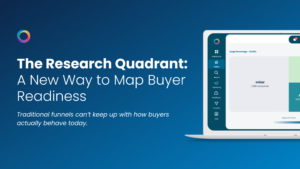What is multi-channel marketing?
Multi-channel marketing refers to brands participating in marketing activities and selling their products or services in more than one channel. Unless your target audience has incredibly specific habits, and only use one channel, then you need to get in front of them on multiple different channels.
Multi-channel marketing is one of the most critical aspects of effective marketing in 2019. With the ever-increasing amount of competition and ‘noise’ on the internet, you have to get in front of your potential customers more so than ever.
It can take up to seven touchpoints until a human interacts with your brand. These touchpoints might include:
• Your website
• Email
• PPC
• Social media
• Your sales agents
• Direct mail
• Blogging
• SMS
While you don’t have to be using all these channels all the time, you do need to be using the channels that your buyer personas are already on. If you need help creating a buyer persona, check out our guide here or listen to our podcast here.
When you know where your audience is hanging out online, then you know what direction to go in, and what language to use when trying to get their attention. If they use Twitter, then you’re going to use short and sweet snippets of your content to engage them, whereas if you’re trying to target them on LinkedIn, then you’re going to use longer statuses, and possibly link to a longer article.
Here are a few more top tips for effective multichannel marketing:
• Build out your buyer personas
• Set SMART goals, and measure them accordingly
• Create relevant content that they want to see and will solve their problems
• Test what works best
• Be consistent, across the most important channels
• Choose a set of channels that work well together
• Create a seamless experience
• Use a CRM tool like Zymplify, to view all your data from each different channel, and find out what is working best for your campaign
If you want to know more top tips for multi-channel marketing, check out our blog post here.
How to create an effective multi-channel marketing strategy
1. Set out clearly defined goals
You need to ask yourself questions like:
How do you want your brand to be perceived?
Whether you want to come across as funny, serious or emotive, you need to set out these specific guidelines from the offset and ensure your entire team are up-to-speed. You want to create a consistent ‘voice’ across all channels, so your audience will recognize you when they see your branding, imagery or read your posts.
What will your unique selling points (USPs) be?
You need to be clear on your USPs and shout them from the rooftops. Get the team together for a brainstorming session and create precise, unique selling points. Use these as the basis of your marketing materials.
What type of ROI will constitute success?
One specific campaign doesn’t need to be directly profitable if it achieves something that will lead to profit. You need to clearly define how you will measure your ROI, whether that’s financial or another metric.
How will you technically measure performance?
It’s one thing to commit to a particular ROI, but it’s another to track it reliably — and, if you can’t do the latter, then the former is essentially meaningless. This is where sophisticated analytics enter the equation. The broader your strategy, the tighter your analytics setup will need to be.
2. Identify and prioritize popular platforms
Take advantage of the relationships you have already created and ask your customers for their help. You can do this directly, or simply release the occasional survey and ask them to complete. Find out what channels they use, and how they spend their time online.
As well as that, you should look at notable influences within the industry you’re trying to tap into. Research social media influencers, and industry leaders, and find out how their audience interacts with them. If your business is new, this will be exceptionally helpful.
3. Cater your content to suit the context
Like we said earlier if you’re trying to target your audience on Twitter and LinkedIn, the format and language you use might differ. You need to create content that can be adapted and customized to suit each platform.
For example, if you have created an article for LinkedIn, you might want to cut it up into highlights, and post these as Tweets, one after the other and create a highlight reel.
However, context goes beyond different channels because you must consider the context of the recipient. When you are building out your buyer personas, you need to consider these factors. What type of content do they consume? What format would they like to read?
4. Save time and effort with automation tools
As busy marketers in 2019, we are all spinning plates. We all have a hundred and one jobs to do, and sometimes it feels like there isn’t enough time in one day, week or month. Marketing automation will give you back your time, and allow you to automate repetitive daily tasks, that generally take up a lot of your working day.
Tasks like email-sends and social media posts can be automated, and scheduled long in advance, so you don’t have to worry about them every day.
5. Anticipate and adapt to upcoming trends
Use effective automation and CRM tools, to measure and monitor every digital click in real-time. You will be able to see exactly what’s working, and what’s not, and make informed decisions instantly. When it comes to multi-channel marketing, you need to make sure you are putting time, effort and energy into the right channels. If you’re wasting your time on an ineffective marketing channel, you could be wasting a lot of money.
Top Tips for each Channel
Email
• Build a list, but clean and audit it regularly
• Define your audience and goals
• Get personal with content
• Be human
• Make it shareable
• Consistency
• Make it easy to unsubscribe
• Optimize for mobile
• Track metrics
Social
• Create a plan for each social media channel
• Consistently
• Use an automated tool and schedule in advance
• Use images and videos
• Measure and analyze
• Don’t be afraid to boost posts
• Get involved with communities, and build your own
• Interact
• Capitalize on hashtags
Mobile
• Speed up your site and make it easy to use
• Mobile optimized – duh!
• Announce promotions via text
• Use video and images effectively
• Optimize for micro-moments
• Voice search
SEO
• Start optimizing your site for mobile devices
• Understand how users search
• Write for humans, optimize for search engines
• Analyze your existing search traffic
• Stay up-to-date with the latest trends
• Never underestimate UX
• Discover the link between social media and SEO
• Voice search
PPC
• Review new features in Google Ads
• Test new platforms
• Mobile preference
• Test new features
• Audiences integrated with Search
• Learn to use scripts
• Voice search preparation
Chatbots
• Ask questions
• Give options that express the personality
• Use video, audio and GIFs
• Keep your sections short
• Update the experience regularly
• Storytelling
Conclusion
We hope that by now, you understand the importance of multi-channel marketing. You need to be getting your product or service out there, in front of your target audience on the channels that they are already using in their own time.
You also need to be able to measure this effectively and know what’s making you money in real-time. There is no point in creating a multi-channel marketing strategy which includes channels that your audience aren’t even using. By using effective marketing automation, or CRM system, you can measure your campaigns from one place, and see what channels are making the most impact.



